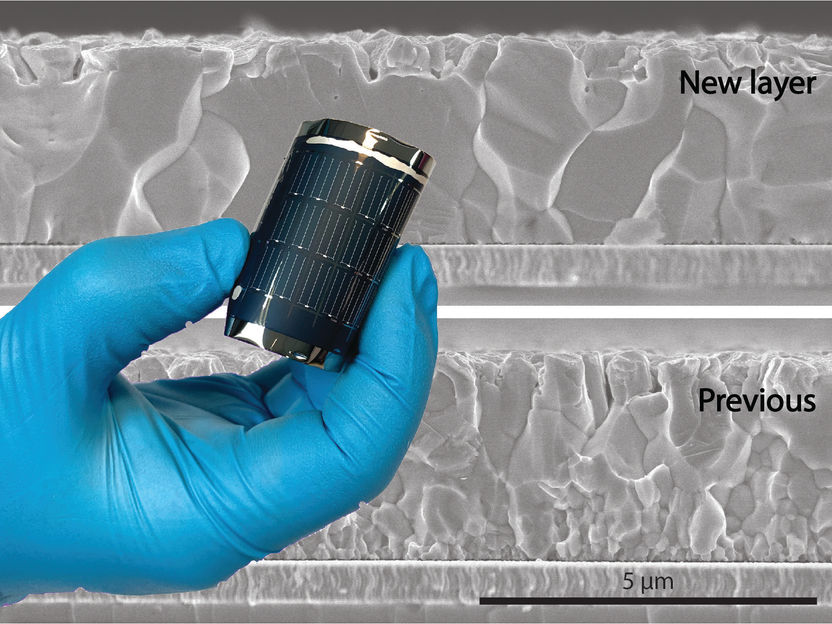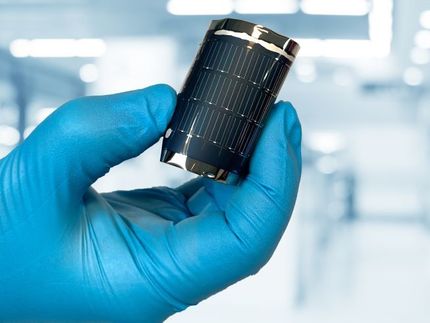Flexible solar cells with record efficiency of 22.2%
Gaining power
One year after announcing an efficiency record, Empa scientists have achieved a new mark of 22.2% for flexible CIGS solar cell on polymer film. solar cells of this type are especially suited for applications on buildings, vehicles, satellites, airships, and mobile devices.

Flexible CIGS solar cells are composed of very thin layers, including a compound composed of the elements copper, indium, gallium and selenium. The layers are deposited onto flexible polymer substrates, mainly by vacuum processes.
Empa
Empa researchers have – once again – improved the efficiency of CIGS flexible solar cells. Independently certified measurements revealed a power conversion efficiency of 22.2% to convert light into electricity, an improvement from their previous record value of 21.4%. To compare, the best efficiency of a rigid crystalline silicon solar cell is 26.7%. The team of Romain Carron, group leader in Empa's Laboratory for Thin Films and Photovoltaics headed by Ayodhya N. Tiwari, presented their newest results at the 8th World Conference on Photovoltaic Energy Conversion (WCPEC-8) on 26 September 2022 in Milano, Italy.
These flexible solar cells are processed on a polymer film with the Cu(In,Ga)Se2 semiconductor layer that absorbs the light deposited by a low-temperature co-evaporation method. Empa scientist Shiro Nishiwaki modified the composition of the layer to improve the device performance and output voltage. "Two approaches explored to alloy the crystal delivered similar improvements in device performance", said Romain Carron. Therefore, the findings can be transferred at industrial scale following different implementations, with equivalent outcomes. The solar cell efficiency of 22.2% was independently measured at the Fraunhofer Institute for Solar Energy Systems ISE in Freiburg, Germany.
Setting new records for 23 years
Ayodhya Tiwari and his team are conducting research on flexible thin film solar cells for more than 23 years. With their profound knowledge of the technology and the fundamental physical processes, they achieved several efficiency records throughout the years. Their "record series" started with 12.8% in 1999, moved to 14.1% (2005), 17.6% (2010), 18.7% (2011), 20.4% (2013), with more recent progress to 20.8% (2019) and 21.4% (2021).
In the regime of high efficiency limits, every small increment requires careful investigation of the factors that limit the performance, and requires innovative approach to overcome the challenge. The current enhancement in efficiency is attributed to alloying the light absorbing semiconductor layer to improve the electronic properties.
Flexible and lightweight solar modules with this technology are especially suited for applications on roofs and facades of buildings, greenhouses, vehicles, airships and portable electronics. Empa collaborates with Swiss company Flisom for roll-to-roll manufacturing of lightweight flexible solar modules for such applications. The research was supported by the Swiss Federal Office of Energy (SFOE).
Other news from the department science

Get the chemical industry in your inbox
By submitting this form you agree that LUMITOS AG will send you the newsletter(s) selected above by email. Your data will not be passed on to third parties. Your data will be stored and processed in accordance with our data protection regulations. LUMITOS may contact you by email for the purpose of advertising or market and opinion surveys. You can revoke your consent at any time without giving reasons to LUMITOS AG, Ernst-Augustin-Str. 2, 12489 Berlin, Germany or by e-mail at revoke@lumitos.com with effect for the future. In addition, each email contains a link to unsubscribe from the corresponding newsletter.



























































